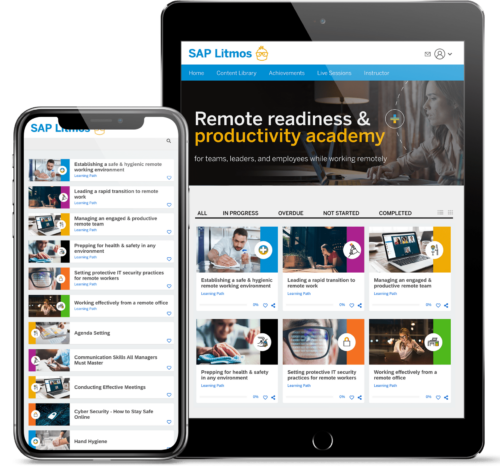Pro Tips for Working from Home Effectively

Since mid-March, because of the coronavirus pandemic, many of us have been sent home from our offices and asked to work virtually, suddenly becoming remote workers. Many of us were already working remotely; one analysis of 2018 U.S. Census data found that five million people were working from home full or part-time. I’m one of these full-time remote folks. I’ve been working from home for 10 years, ever since I left my job as a news reporter and went freelance.
I’ve been getting a lot of calls this past week about working from home. How do you do it successfully? How do you manage time effectively, meet deadlines, hold meetings without locking your family or your roommates in the basement, and how do you do all this without eating the entire contents of your fridge by dinnertime?
What follows are some of the tools, tips, and tricks I use for maintaining a work schedule, setting up my home office, and not getting too distracted by the Internet. In addition to my ideas, here’s a good, online guide to working from home that I found, as well.
Can I expect to be as productive at home?
First, a confession: in the last week I have not been working from home effectively. Like everyone reading this, I’ve had to make adjustments. My child is home from school, my spouse is home from work, and we’re all stressed out by the news about coronavirus, and by the uncertainty that surrounds the pandemic and our situation. So, I’ve definitely not been an effective home-based worker.
That’s my first and best tip for starting to work remotely: don’t expect a seamless shift from the office to your home. As we adjust to new technologies, a new situation, and the reality of working right next to our families and roommates, our productivity is going to drop (especially if you’re now homeschooling your child or directing their distance learning). You simply can’t expect yourself to have the same level output while you’re transitioning to remote work.
When I started working from home 10 years ago, I wasn’t a parent and there was no pandemic. Even then, it was difficult to make the transition. I went from a noisy newsroom and the demands of a boss who sat near me to the distracting silence of my home. It was hard to concentrate at first — so if you’re struggling now, no worries. This is normal.
Stay calm and soldier on! You will develop new routines and your productivity will rise.
Where in my home should I work?
This is a big one. You need to have a space for work. This may be complicated if you have a small living space or if everybody is home right now and needs their own space for work or study.
Claim a space that can be your workspace during the day. If you have a home office, that is good, but it doesn’t need to be a home office. What you need is space that accommodates your work and that will not hurt you. Offices often have ergonomic furniture that are meant to support you for a long time. Your kitchen table, not so much. If you find yourself working at a dining room table, on a couch, or on your bed, be aware of how you’re sitting, and be sure to get up and move around every once in a while. You don’t want to hurt your back because you’ve been in a weird position for too long.
How do I handle remote meetings and phone calls?
If you’re worried about running a remote meeting, you should check out the free learning courses in Litmos’ Remote Readiness & Productivity Academy. There are courses on topics such as “Conducting Effective Meetings,” “Agenda Setting,” and “Managing Virtual Teams.”
If you’re worried about attending online meetings, here’s some advice:
-
Members of the Litmos Marketing team having fun with backgrounds
Take advantage of cool, video conferencing options: If you’re concerned about your co-workers seeing your messy house, or your pets and kids running around in the background, use the Backgrounds feature in apps like Zoom. You can download any image to serve as your background or use any of the standard ones built into the platform. This can be a fun way for teams to see each other’s individual styles or interests. But, use your best judgement when meeting with external people; they might not find your beach background as entertaining as your colleagues do. I also recommend keeping a “meeting shirt” on hand — a decent sweater or jacket in your work area for jumping on calls. One of my friends jokes about keeping a “good hoodie” in his office for meetings. Good idea!
- Keep it simple if you’re stressing: If you’re really distracted by what’s going on in your physical environment (again, kids, pets, the neighbor blasting music, etc.), it’s probably wiser to just join the meeting with audio only. You can mute yourself as needed and feel more confident in maintaining your professionalism, in spite of your dog who won’t stop barking or the cat who keeps jumping in your lap. Everyone is in the same boat and people are more understanding than not — because every work-at-home parent is BBC Dad now. Phone calls can also get complicated. I have to hide when I’m on calls because my child thinks I’m on the phone with his grandparents. You also might not have great reception, so look into wi-fi calling, if that’s the case.
How can I manage my time while working from home?
There are several ways to handle time management when you don’t have a boss or co-workers in your immediate vicinity. Your workplace might even provide task and time management tools for you, like Wrike, Trello, or Asana.
But when you’re at home — and especially if your home is filled with other people right now — those digital tools might not be enough to keep you on task. I recommend keeping some simpler tools on hand:
- A list (paper or digital, it does not matter)
- A timer (your phone will do)
- If you want to get fancy, a free time tracker, like Timecamp or Toggl
At the start of the day, make a list of all the tasks you have to do. Keep it as manageable as you can.
Then, if you’re having a hard time getting started, or if you’re feeling distracted, set the timer and commit to one of the tasks for 15 minutes. By the time it goes off, I’m willing to bet you will be well into that task, or perhaps through it and into the next. Check it off your list and keep going. If you need a more structured system, check out the Pomodoro system, or allocate certain amounts of time to each task on your list.
Make sure to take breaks. That’s a perk of working from home. You can take breaks whenever you need to and no one will side-eye you.
But as you take your breaks remember this: researchers find that if a knowledge worker is interrupted at work, it takes 10 to 20 times the duration of the interruption for them to recover and get back to their previous task. Some studies show it takes an average of 23 minutes and 15 seconds for workers to get back to a previous task after any interruption at all — so, if you run to the fridge right in the middle of a task that requires all your concentration, it might take you 20 minutes to get back to work.
This is where the time tracker comes in. Time trackers are very helpful when it comes to knowing exactly how long you spend on any one task. They’ll also help you know how long your interruptions are.
What if my home is full of other people?
If you’re working from home with your family, partner, or roommates, you might not be able to control your interruptions — especially if you’ve got small children, family members with special needs, or kids of any age whose schooling is now dependent on you.

Other than that, here are some guidelines, based on my own experience. If you have children and a partner, alternate working hours as much as possible so you can give each other a break.
Normally, I try to stick to regular business hours and protect my working time as much as possible. My family is trained not to come near my office during working hours, but these have been extraordinary times, and my husband needs a break, so I’ve started to let my child “work” in my office with me. I’ve also started spreading out work hours so I can spend more time with my family during the day. What is quarantine good for if I can’t spend it with my favorite people? Work can wait for naptime or early in the morning.
That’s just me, though. Find the times when you’re comfortable working. Be flexible, because as you get better at working from home you’ll find that working remotely can be highly individual. There are certain rhythms that will work well for you, your household, and your workplace. In the next few weeks, you’ll start learning what those are.
For more help, take advantage of the free courses offered by Litmos in the Remote Readiness & Productivity Academy. All classes are free through the end of June 2020!






